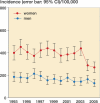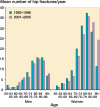The hip fracture incidence curve is shifting to the right
- PMID: 19916682
- PMCID: PMC2823331
- DOI: 10.3109/17453670903278282
The hip fracture incidence curve is shifting to the right
Abstract
Background: The number of hip fractures has doubled in the last 30-40 years in many countries. Age-adjusted incidence has been reported to be decreasing in Europe and North America, but is there a decreasing trend in all age groups?
Patients and methods: This population-based study included all hip-fracture patients over 50 years of age (a total of 2,919 individuals, 31% of whom were men) admitted to Umeå University Hospital, Sweden, from 1993 through 2005.
Results: The incidence of hip fracture declined between the periods 1993-1996 and 2001-2005: from 706 to 625 hip fractures per 10(5) women and from 390 to 317 hip fractures per 10(5) men. However, there was a 114% increase in the number of fractures in women aged 90 or older (12 and 25 hip fractures/year, respectively, in the two time periods). For the period 2001-05, women > or = 90 years of age accounted for almost the same numbers of hip fractures as women aged 75-79 (27 fractures/year). The rate increased during this period, from 2,700 per 10(5) women to 3,900 per 10(5) women > 90 years. In men there were declining trends for both relative and absolute numbers.
Interpretation: Although age-adjusted incidence declined in the population > 50 years of age, absolute fracture rate and incidence increased in the very old. Women over 90 now have the same absolute number of hip fractures every year as women aged 75-79 years. There was a right-shift in hip fracture distribution towards the oldest old, probably due to an increased number of octo/nonagenarians, a new population of particularly frail old people that hardly existed earlier. Better health among septuagenarians may also have delayed the age at which fractures occurred. This changing pattern will strain orthopedic and geriatric resources even more.
Figures





References
-
- Bergström U, Björnstig U, Stenlund H, Jonsson H, Svensson O. Fracture mechanisms and fracture pattern in men and women aged 50 years and older: a study of a 12-year population-based injury register, Umeå, Sweden. Osteoporos Int. 2008;19((9)):1267–73. - PubMed
-
- Chevalley T, Guilley E, Herrmann FR, Hoffmeyer P, Rapin CH, Rizzoli R. Incidence of hip fracture over a 10-year period (1991-2000): reversal of a secular trend. Bone. 2008;40((5)):1284–9. - PubMed
-
- Giversen IM. Time trends of age-adjusted incidence rates of first hip fractures: a register-based study among older people in Viborg County, Denmark, 1987-1997. Osteoporos Int. 2007;17((4)):552–64. - PubMed
-
- Gustafson Y, Brännström B, Berggren D, Ragnarsson J-I, Sigaard J, Bucht G, Reiz S, Norberg A, Winblad B. A geriatric-anesthesiologic program aimed at reducing acute confusional states in elderly patients treated for femoral neck fractures. J Am Geriatr Soc. 2006;39:655–62. - PubMed
-
- Hallström B, Jönsson AC, Nerbrand C, Norrving B, Lindgren A. Stroke incidence and survival in the beginning of the 21st century in southern Sweden. Comparison with the late 20th century and projections into the future. Stroke. 1991;39:10–5. - PubMed
MeSH terms
LinkOut - more resources
Full Text Sources
Medical
